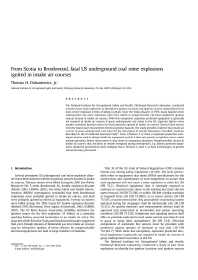Mining Publication: From Scotia to Brookwood, Fatal US Underground Coal Mine Explosions Ignited in Intake Air Courses
Original creation date: January 2009
The National Institute for Occupational Safety and Health, Pittsburgh Research Laboratory, conducted a study of past mine explosions to identify the ignition locations and ignition sources responsible for the most severe explosion events resulting in death. Since the Scotia disaster of 1976, many fatalities from underground coal mine explosions have been linked to non-permissible electrical equipment ignition sources located in intake air courses. With few exceptions, explosion protected equipment is generally not required in intake air courses of gassy underground coal mines in the US. Cigarette lighters were another prevalent ignition source for fatal explosions ignited in intake air courses. Several mine rescue/recovery teams have encountered electrical ignition hazards. The study provides evidence that intake air courses of gassy underground coal mines fit the description of certain Hazardous (classified) locations described in the US National Electrical Code®. Class I Division 2 or Zone 2 explosion protection techniques may be used to design intake air equipment so that it does not present an ignition source under normal operation, before mine power is shut down in emergency situations. Non-permissible circuits in intake air courses that are likely to remain energized during emergencies, e.g. battery-powered equipment, should be protected by more stringent Class I Division 1, Zone 1, or Zone 0 techniques, to protect rescue/recovery personnel.
Authors: TH Dubaniewicz
Peer Reviewed Journal Article - January 2009
NIOSHTIC2 Number: 20034793
J Loss Prev Process Ind 2009 Jan;22(1) :52-58
See Also
- Electrical Safety
- Historical Mine Disasters
- Passive Fiber Optic System for Locating, Tracking, and Communicating with Personnel in Coal Mines
- Refuge Alternatives in Underground Coal Mines
- Remote Methane Sensors
- Roof and Rib Fall Incident Trends: a 10-Year Profile
- Safe and Economical Inerting of Sealed Mine Areas
- Support Design Procedures for Difficult Ground Conditions
- Technical Solutions for Enhancements to Mine Safety Using Barricade II Fire Blocking Gel
- Underground Coal Mining Disasters and Fatalities: United States, 1900-2006
- Wireless Mesh Mine Communication System
- Content source: National Institute for Occupational Safety and Health, Mining Program


 ShareCompartir
ShareCompartir
